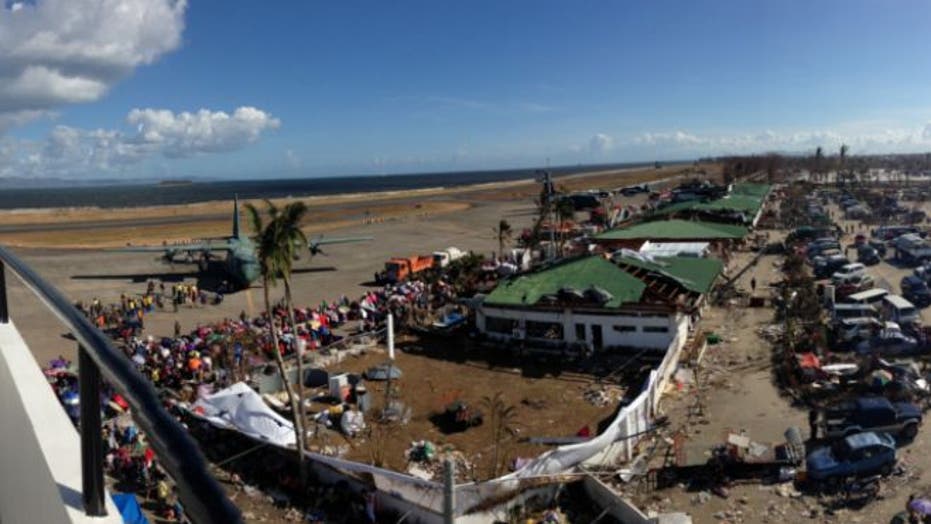TACLOBAN, Philippines – It was a ride to never forget. Escaping hell on earth in the belly of giant US transport, stuffed in like sardines in what felt like a record - 683 passengers sitting cross legged on the floor of a C-17 cargo aircraft.
It was a Monday morning in the infamous, urine soaked Tacloban Airport in the Philippines, a dumping ground of desperate humanity attempting to flee one of the worst disasters ever – a combination typhoon-tsunami that wiped out homes in 36 provinces and inundated some 125 miles of coastline.
A U.S. Marine led us onto the chaotic tarmac, littered with giant pallets of food, trucks, planes, helicopters and of course people – thousands still trying to leave. Stray dogs moved among the masses, looking for scraps of food and high energy biscuits from the mountains of boxes of aid stacked throughout the airport. Planes landed every few minutes from around the world – Sweden, Singapore, Malaysia, Australia – loaded with supplies. Most were the C-130 – an American-built cargo plane. Once offloaded, the U.S. and Philippine C-130s were loaded with evacuees – and sent either to Manilla or Cebu, the country’s second largest city.
Each C-130 was crammed with about 120 people. After more than 400 flights, the US had evacuated roughly 4,000 from Tacloban.
But the C-130 isn’t large enough to transport the heavy equipment, like cargo trucks, backhoes and bulldozers needed now. For that the US Air Force brought in three Boeing C-17s, one the largest military transports in the world. It’s among the most successful planes ever built, doing the heavy lifting for the Air Force since 1993.
The plane is so big, it can’t fit on the tarmac – so the Marines escorted this odd assortment of passengers – international aid workers, journalists and a mass of hungry and homeless Filipinos onto the runway. We entered the jumbo jet on a long ramp into the cavernous bay. Jump seats on the side of the plane were reserved for women, children and the injured.
The engines never shut down, so senior airman Samantha Holley yelled. She instructed everyone to sit down and put a cargo strap over our legs. “Move forward, move forward, move forward,” she screamed.
Everyone stunk. Since the typhoon, there’d been no running water. With high humidity, and 90 degree days, and no change of clothes, the cargo bay smelled like a heap of trash.
As the plane filed up, the hard steel floor began to hurt. You can only sit cross-legged so long before your legs begin to cramp. But by now, sitting shoulder to shoulder with some stranger, your knees in their back, there was no where to go.
After every inch of the cargo hold was jammed with passengers, the plane took off. It was too loud inside to talk, so everyone either looked down or closed their eyes. After a week here, we’d gotten at most two hours of sleep a night, usually on the concrete tarmac in the same clothes we arrived. Between the rain and the roar of arriving planes every few minutes, I am sure others didn’t have it any better. Exhausted, everyone was just happy to get out, especially the locals. They’d just been beaten and broken by a fierce storm, left with nothing but their life. Many didn’t know where they were going, but knew it was better than the smell of death and bloated corpses they left behind.
Half way through the trip, Holley connected her phone to the plane’s speaker system and suddenly music boomed into a cabin usually reserved for tanks and giant generators.
"I'm coming home. I'm coming home, tell the world I'm coming home."
The song sung by Skylar Grey energized the emotionally drained group. Some cried, some laughed, but for the first time since arriving I saw typhoon ravaged Filipino’s smile.
“Let the rain wash away all the pain of yesterday I know my kingdom awaits and they've forgiven my mistakes I'm coming home, I'm coming home. Tell the world I'm coming home.”
Airman Holley began to wave her arms to the music, and the many in crowded plane followed suit. A stadium wave inside a C-17. It had to be a first!
The plane normally carried 102 paratroopers, or 120 soldiers. It once carried Keiko the killer whale to Iceland. But this was a record for the C-17. The world record for a single flight passenger load is 1,122, held by a stripped down 747.
After an hour, we landed effortlessly in Manila. The plane erupted in cheers. As people began to exit, a man injured in the flood, couldn’t get down the stairs. Two Air Force pilots from the 535th Airlift Squadron caught him as he fell, and carried him to an awaiting bus.
After leaving here, the C-17 out of Hawaii would go to Japan, load more heavy equipment and return to Tacloban, where the exodus from hell would continue.

